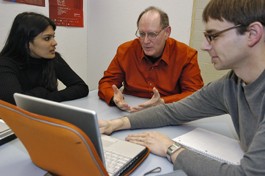
In National Survey, Employers Say UC Designer Is Textbook Example of Excellence
Craig Vogel of the University of Cincinnatis top-ranked College of Design, Architecture, Art, and Planning (DAAP) keeps good company Procter & Gamble, Whirlpool, Motorola, New Balance, Alcoa, Ford Motor Company, Lenovo, Lubrizol .
They are all firms that hes helped, guiding them in the integration of top-selling style with technology such that form and function come together to fulfill consumers fantasies.
He does the same in his teaching role at UC, and thats why hes just been named to a short list of Americas Most Admired Industrial Design Educators 2006. That list appeared in the December 2005 issue of DesignIntelligence magazine, a design industry publication of the Design Futures Council. Every December, the magazine publishes the results of its annual survey of architecture, design and engineering employers regarding the nations best design programs. UC again made that list this past year with the nations
- Number one undergraduate interior design program (for the 7th straight year)
- Number one architecture program among the magazines Top Ten Most Innovative Architecture Programs
- Number two in terms of overall quality of the architecture program
- Number two industrial design program
In the rankings, UC beat out such East Coast rivals as Harvard, Yale, Princeton, Columbia and Cornell on the strengths of its Top Ten co-op program (ranked among the nations elite by U.S. News & World Report), the challenging curriculum at DAAP and the excellence of its design faculty.
For the first time this year, the 2006 blue-ribbon rankings also included a listing of the nations best design faculty. UC had four faculty members on that list Craig Vogel, Tony Kawanari, Gerry Michaud and Dale Murray. Only one other school in the nation (Art Center in California) had as many.
In finding his name on DesignIntelligences short list, Craig is a little perplexed because he says, I actually want my students to be imperfect. Neither the perfect student nor the perfect course nor the perfect professor actually exists. The problems and challenges we take on in the classroom and industry are too complex. We often start with absolutely nothing but a very knotty problem. Then, the students and professionals I work with end up devising the most incredible solutions, often quite radically different from one another. There is no single perfect solution. There are actually plenty of them!
So, as a teacher with years of experience in terms of working with industry, Craig basically sees his role as one of asking questions from the vantage point of his experience in creating products that encompass consumers emotions, aesthetics, technology, quality and brand identity.
Ive worked with so many industries, collaborated with engineers and business professionals that I simply direct my questions toward all the ramifications that a students design idea might have. Its not that Im smarter than my students. In fact, I more than trust their capabilities. Its just that I have insights that come from experience. So we team up to take risks together. In the classroom, we go from boring to thrilling in a single second, he laughs.
If, 25 years from now, Craigs students are looking back and ranking his teaching style and ability, what does he hope they remember? That I helped them be more comfortable with being uncomfortable, more comfortable with asking hard questions, that I helped them become more of who they already were, says Craig, adding, That I helped them see all that they can do.
Craig also hopes he prompts such seeing beyond the classroom doors too. Hes literally sought out around the world to guide both start-up firms and corporations through the process of product innovation. His two books hes co-authored The Design of Things to Come: How Ordinary People Create Extraordinary Products (Wharton School Publishing) and Creating Breakthrough Products: Innovation from Product Planning to Program Approval (Prentice Hall) are the textbooks of business innovation and of business/design school collaborations.
Related Stories
UC’s Ground Floor Makerspace births combat robots
April 17, 2024
In the heart of UC's 1819 Innovation Hub lies the Ground Floor Makerspace, an advanced and active hub of ingenuity where students, faculty and the community converge to bring their ideas to life. This includes being the birthplace of robots much like miniature race cars, combating fender to fender in an enclosed boxing ring. Combat robots like UC's Maximizer will again be fighting for first place in the National Havoc Robot League (NHRL) competition, slated for April 20.
UC President Neville Pinto shares 2024 State of the University...
April 16, 2024
University of Cincinnati President Neville G. Pinto shared his 2024 Sate of the University address with the campus community on April 15.
UC marketing intern enjoys a bite of the Big Apple
April 16, 2024
Kaylen Rolsen, a graduating senior at the University of Cincinnati, shares her thoughts about her latest cooperative education experience with Macy's. Rolsen, who is majoring in marketing and minoring in fashion studies, definitely recommends a summer in New York City, the Big Apple.
